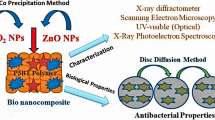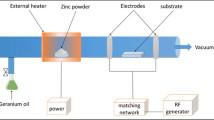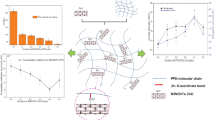Abstract
ZnO/palygorskite nanocomposites were synthesized by chemical deposition and calcination process for antibacterial application. The results indicated that ZnO nanoparticles were deposited on the surface of rod-like palygorskite. Antibacterial evaluation confirmed that ZnO/PAL nanocomposites presented the good antibacterial behavior against Escherichia coli and Staphylococcus aureus, which was mainly attributed to the synergistic effect of ZnO and palygorskite.
You have full access to this open access chapter, Download conference paper PDF
Similar content being viewed by others
Keywords
1 Introduction
Widespread overuse of the antibiotics on animals has been faulted for creating potentially threat for human beings (Li et al. 2014; Mckenna 2013). Antibiotic-resistant bacterial strains emerge and pose increasing health risks, and thus new antibacterials are urgently needed (Morrison et al. 2014). Inspired by the antibacterial property of nanocomposites in the nature, functional application of natural clay minerals are of great interest in academia and industry (Williams et al. 2011). It is well-known that zinc oxide (ZnO) possesses excellent antibacterial properties against gram-positive bacteria and gram-negative bacteria (Hui et al. 2016; Liu et al. 2019). However, it is difficult to prevent from the aggregation of ZnO nanoparticles during preparation process, which results in the adverse effects of the antibacterial properties. Palygorskite (PAL) as a kind of clay minerals is common in many parts of the world, typically forming in volcanic ash layers as rocks. Interestingly, PAL has one-dimensional rod like morphology, high specific surface area and better ion-exchange capacity, which can be adsorbed onto the bacterial cell by electrostatic adsorption. Therefore, it seems to be a promising attempt to achieve a possible synergistic effect by combine PAL and ZnO after loading ZnO nanoparticles on the surface of PAL. Therefore, ZnO/palygorskite (ZnO/PAL) nanocomposites were synthesized by chemical deposition and calcination process in this study, and the antibacterial properties against Escherichia coli (E. coli) and Staphylococcus aureus (S. aureus) were also investigated.
2 Methods and Approaches
Fabrication of ZnO/PAL Nanocomposites:
In a typical synthesis of ZnO/PAL nanocomposites, 2 g PAL and 20 wt% Zn(NO3)2·6H2O were dissolved into deionized water, and then 10 wt% NaOH solution was added into above solution for 2 h. The mixture was ultrasonically dispersed for 30 min and aged for 24 h. The powder was collected by centrifugation and dried at 80 ℃ for 6 h, and finally annealed at 400 ℃ for 3 h in muffle furnace.
Characterization:
The products were characterized by X-ray diffractometer (XRD, D/MAX-2200, Rigaku, Japan), transmission electron microscopy (TEM, JEM-1200EX, FEI, USA) and energy dispersive spectroscopy (EDS) elemental composition analyzer. The specific surface area of the samples was evaluated by Brunauer-Emmett-Teller analysis (BET, Micromeritics, Norcross, USA).
Antibacterial Evaluation:
E. coli and S. aureus were tested as a representative culture both Gram-negative and Gram-positive bacteria, which kindly provided by China Veterinary Culture Collection Center. The antibacterial activity of the sample was evaluated by examining the minimum inhibitory concentration (MIC).
3 Results and Discussion
The XRD patterns of PAL and ZnO/PAL nanocomposites were shown in Fig. 1. The diffraction peaks at 2θ of 8.38°, 13.74°, 16.34° and 34.38° were the characteristic peaks of PAL (Wang et al. 2015). The diffraction peaks of the obtained ZnO/PAL were corresponded to a wurtzite ZnO structure (JCPDS standard card 36-1451) (Hui et al. 2016).
The morphology of ZnO/PAL nanocomposites presented rod-like structure with a rough surface, and the length and the diameter were around 200 ~ 300 nm and a 30 nm, respectively (Fig. 2a), which indicated that ZnO nanoparticles were successfully loaded onto the rod-like PAL surface to form a heterostructure. The specific surface area of PAL and ZnO/PAL was found to be 173 m2·g−1 and 56 m2·g−1, respectively. Compared with pure ZnO, this strategy could obviously improve the specific surface area of ZnO, which was favorable to enhance the antibacterial activity of ZnO/PAL nanocomposites. The ring-type selected area electron diffraction pattern indicated the generated ZnO possessed polycrystalline nature (Fig. 2b). What’s more, EDS result showed the surface element compositions of the as-prepared nanocomposites were Mg, Al, Si, Fe and Zn (Fig. 2c).
As illustrated in Fig. 3, the microbial colonies of E. coli was visible when the concentration of sample was 0.25 mg·mL−1, therefore, the MIC value of sample against E. coli was 0.5 mg·mL−1. By contrast, there was small S. aureus colonies appeared in the plate when the sample contacts with S. aureus (Fig. 3i), and thus the MIC value of sample against S. aureu was 2.5 mg·mL−1.
In fact, PAL as a natural carrier with large special area, could absorb the bacterial cell by electrostatic adsorption. The reason for the synergistic antibacterial effect of ZnO/PAL nanocomposites was mainly due to the active factor of ZnO, which generated reactive oxygen species such as OH, O 12 , O22− and H2O2 (Hui et al. 2016; Liu et al. 2019; Ma et al. 2015). Incorporation of ZnO not only enhanced the antibacterial activity of natural PAL, but also reduced the cost of the preparation process, as well as efficiently realized the functional utilization of natural clay mineral resources.
4 Conclusions
In summary, ZnO/PAL nanocomposites were synthesized by chemical deposition and calcination process. The ZnO/PAL nanocomposites exhibited the excellent antibacterial activity against E. coli and S. aureus, and the MIC values for E. coli and S. aureus were 0.5 and 2.5 mg·mL−1, respectively.
References
Hui AP, Liu JL, Ma JZ (2016) Synthesis and morphology-dependent antimicrobial activity of cerium doped flower-shaped ZnO crystallites under visible light irradiation. Colloid Surf A: Physicochem Eng Aspects 506:519–525
Li XN, Robinson SM, Gupta A, Saha K, Jiang ZW, Moyano DF, Sahar A, Riley MA, Rotello VM (2014) Functional gold nanoparticles as potent antimicrobial agents against multi-drug-resistant bacteria. ACS Nano 8:10682–10686
Liu JL, Wang YH, Ma JZ, Peng Y, Wang AQ (2019) A review on bidirectional analogies between the photocatalysis and antibacterial properties of ZnO. J Alloy Compd 783:898–918
Ma JZ, Hui AP, Liu JL, Bao Y (2015) Controllable synthesis of highly efficient antimicrobial agent-Fe doped sea urchin-like ZnO nanoparticles. Mater Lett 158:420–423
Mckenna M (2013) Antibiotic resistance: the last resort. Nature 499:394–396
Morrison KD, Underwood JC, Metge DW, Eberl DD, Williams LB (2014) Mineralogical variables that control the antibacterial effectiveness of a natural clay deposit. Environ Geochem Health 36:613–631
Wang WB, Zhang ZF, Tian GY, Wang AQ (2015) From nanorods of palygorskite to nanosheets of smectite via a one-step hydrothermal process. RSC Adv 5:58107–58115
Williams LB, Metge DW, Eberl DD, Harvey RW, Turner AG, Prapaipong P, Poret-Peterson AT (2011) What makes a natural clay antibacterial? Environ Sci Technol 45:3768–3773
Acknowledgements
This work was financially supported by the Major Projects of the National Natural Science Foundation of Gansu, China (18JR4RA001).
Author information
Authors and Affiliations
Corresponding author
Editor information
Editors and Affiliations
Rights and permissions
Open Access This chapter is licensed under the terms of the Creative Commons Attribution 4.0 International License (http://creativecommons.org/licenses/by/4.0/), which permits use, sharing, adaptation, distribution and reproduction in any medium or format, as long as you give appropriate credit to the original author(s) and the source, provide a link to the Creative Commons license and indicate if changes were made.
The images or other third party material in this chapter are included in the chapter's Creative Commons license, unless indicated otherwise in a credit line to the material. If material is not included in the chapter's Creative Commons license and your intended use is not permitted by statutory regulation or exceeds the permitted use, you will need to obtain permission directly from the copyright holder.
Copyright information
© 2019 The Author(s)
About this paper
Cite this paper
Kang, Y., Hui, A., Wang, A. (2019). Fabrication of ZnO/Palygorskite Nanocomposites for Antibacterial Application. In: Glagolev, S. (eds) 14th International Congress for Applied Mineralogy (ICAM2019). ICAM 2019. Springer Proceedings in Earth and Environmental Sciences. Springer, Cham. https://doi.org/10.1007/978-3-030-22974-0_102
Download citation
DOI: https://doi.org/10.1007/978-3-030-22974-0_102
Published:
Publisher Name: Springer, Cham
Print ISBN: 978-3-030-22973-3
Online ISBN: 978-3-030-22974-0
eBook Packages: Earth and Environmental ScienceEarth and Environmental Science (R0)







